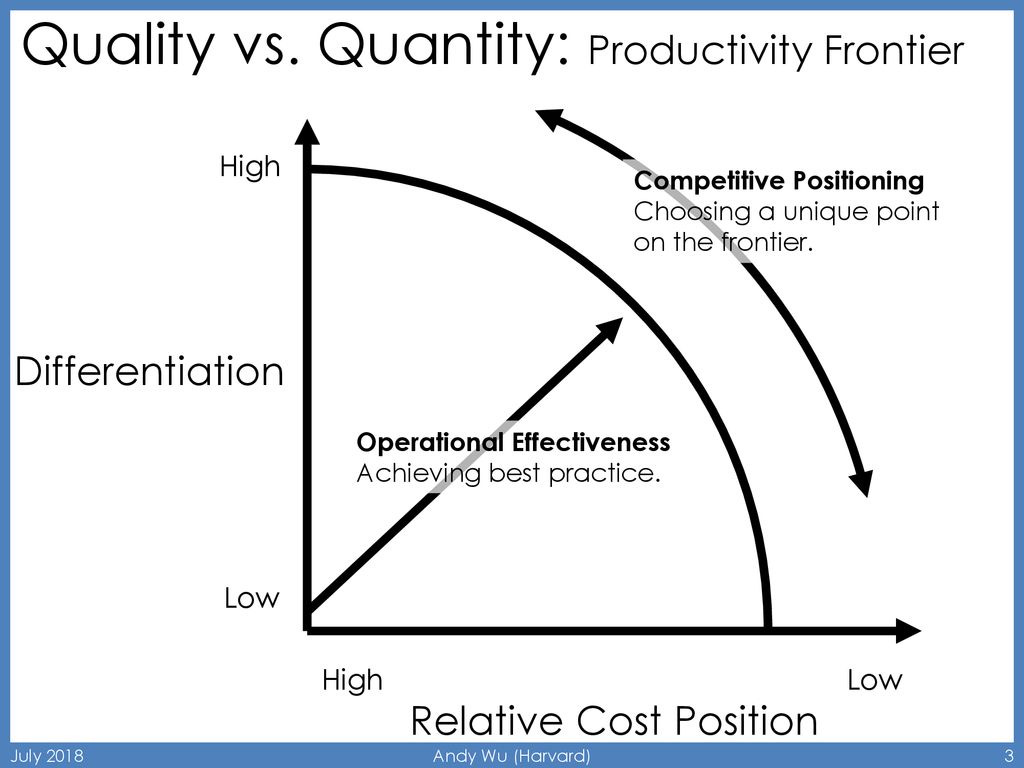AI Pushes the Productivity Frontier, But Strategy Still Wins
Why AI-driven efficiency alone won’t set your company apart—and how strategic clarity and thoughtful leadership remain the ultimate competitive advantage.
Artificial Intelligence is rewriting the rules of operational efficiency. It’s automating tasks that once consumed hours of human effort, driving costs down, and pushing the productivity frontier outward. Yet for all the hype about AI creating competitive advantage, there’s a hard truth that many leaders overlook: efficiency alone is not strategy.
Michael Porter’s classic insight still holds—operational effectiveness and strategy are not the same thing. AI is the latest in a long line of management tools and technologies that help companies perform similar activities faster and better. But just as with total quality management or lean production, these improvements are quickly copied. When every competitor adopts similar AI-powered efficiencies, the baseline rises for everyone, but no one truly stands apart.

Operational Effectiveness vs. Strategy
Porter draws a clear distinction: operational effectiveness means performing similar activities better than rivals, while strategy is about performing different activities—or performing similar ones in unique ways that create a distinctive position. AI excels at the first. It can optimize logistics, generate insights from data, and even create content. But these are all activities that anyone can access with the same tools and algorithms.
When everyone has access to similar AI models, the playing field flattens. The result is what Porter calls competitive convergence—companies start to look the same, chasing similar metrics with similar technologies. The productivity frontier shifts outward, but relative advantage disappears.
The Productivity Frontier and AI
The productivity frontier defines the maximum value a company can deliver at a given cost, using the best available tools and techniques. AI is pushing this frontier outward at an unprecedented pace. Tasks that once required specialized skills—such as data analysis, content generation, or predictive modeling—are now within reach for any organization with the right AI tools.
This is good news for customers and markets; they benefit from faster, cheaper, and better products and services. But for companies, it means the bar is constantly rising. AI-driven improvements, while necessary, are rarely sufficient for long-term differentiation.
Why AI Doesn’t Create Strategic Value
AI can optimize the “how,” but it can’t define the “why.” Strategy requires making trade-offs and creating a unique mix of activities that reinforce one another. It’s about deciding what not to do as much as what to do. These are fundamentally human decisions that demand context, vision, and values—qualities AI does not possess.
The trap is clear: companies that equate AI adoption with strategic advantage will find themselves in a race they can’t win. The tools are too accessible, and the gains too easy to replicate. Real advantage comes from how you integrate AI into a coherent strategy that reflects who you are as an organization.
Praxis and Leadership in the AI Era
This is where praxis—thoughtful doing—becomes essential. Leaders must use AI to free time and mental energy for higher-order work: clarifying purpose, making hard trade-offs, and building organizational cultures that reflect their values. Praxis is the human differentiator in an AI-driven landscape.
AI might automate repetitive action, but it cannot engage in reflective, value-driven decision-making. It cannot discern what kind of company you want to become or how to create human flourishing. Leaders must connect belief and action, ensuring that technology supports, rather than replaces, the distinctiveness of their organization.
The Case for Strategic Differentiation
Porter’s examples—Southwest Airlines, Ikea, Vanguard—show that enduring success comes from unique, reinforcing choices. These companies didn’t win by being the most efficient at generic tasks; they won by designing activity systems that rivals couldn’t easily copy.
In the same way, AI should be seen as a tool to enhance and support a distinctive value chain. For instance, a retailer might use AI to personalize customer experiences not simply to sell more products, but to deliver on a brand promise of deep customer understanding and trust—something competitors can’t replicate with off-the-shelf models.
Beyond the AI Arms Race
AI is a powerful lever for operational effectiveness, but it is not a strategy. The companies that thrive will be those that see AI as a tool to amplify their unique position, not as an end in itself. Leaders must resist the temptation to chase every new AI capability and instead focus on the human, strategic questions that truly set them apart.
The challenge is not to go faster, but to go somewhere only your organization can. The most critical question is not, “How can we use AI to get better?” but, “How can we use AI to strengthen the distinctive value we bring to the world?”
Where will you focus your energy—on chasing AI-driven efficiency, or on building the kind of strategic clarity that AI can never replicate?

